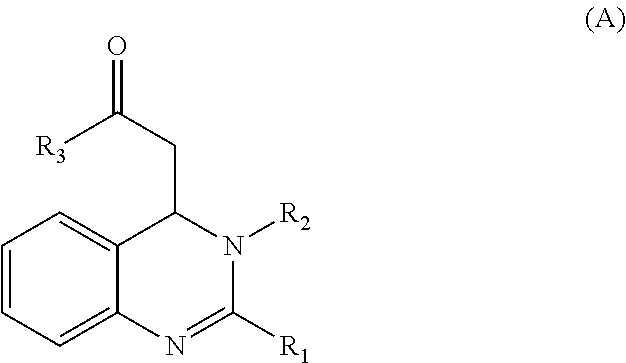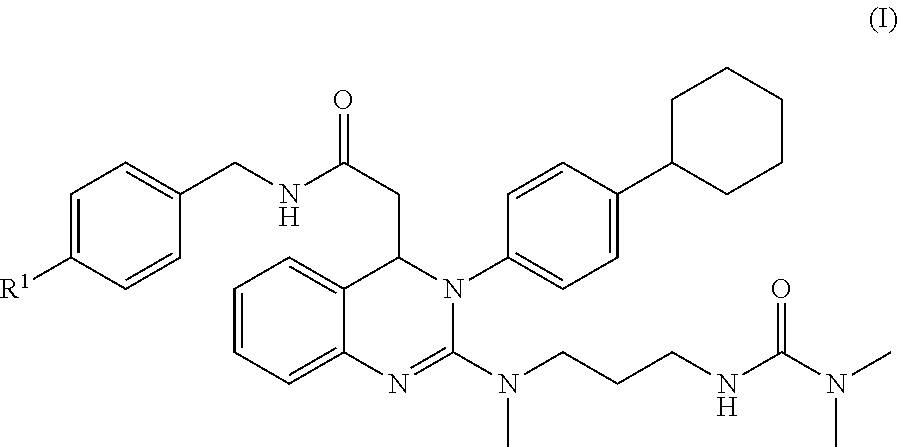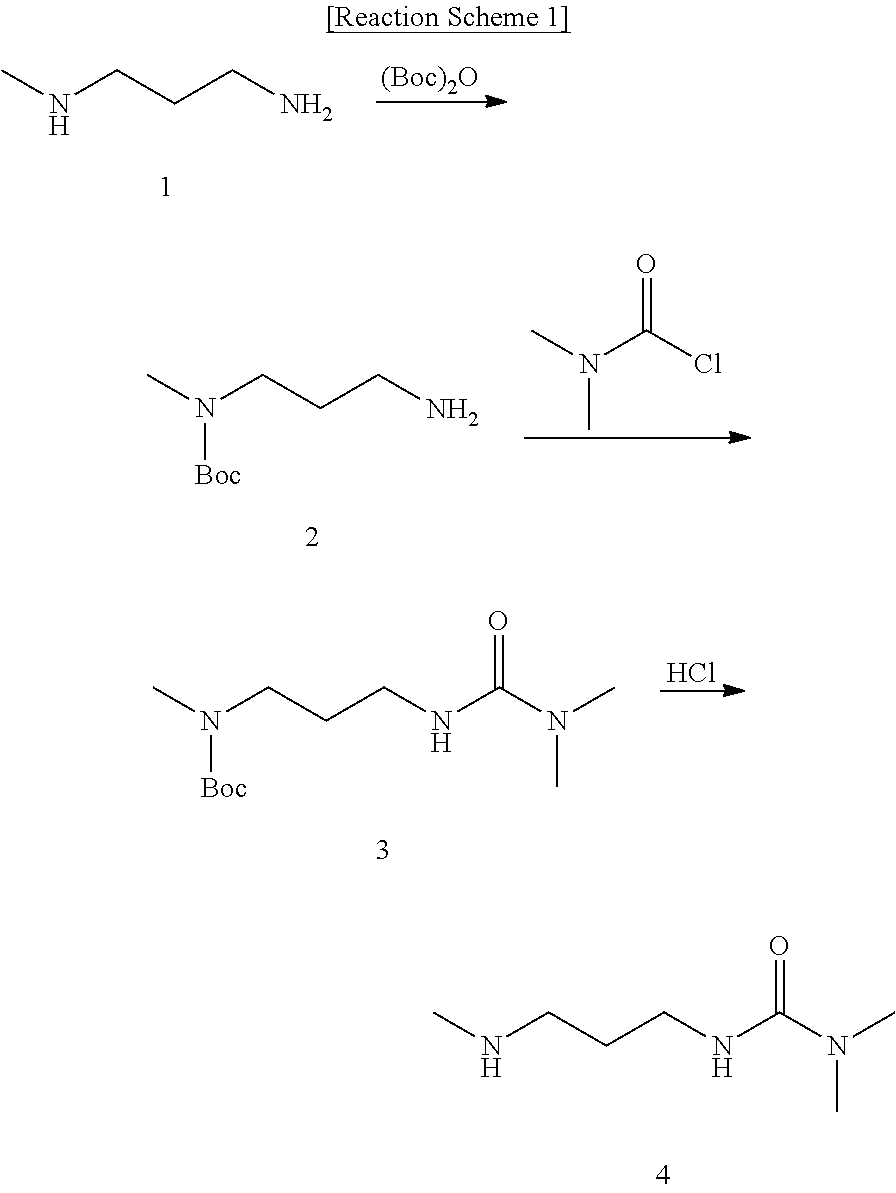3,4-dihydroquinazoline derivative and combination comprising the same
a technology of dihydroquinazoline and dihydroquinazoline, which is applied in the direction of heavy metal active ingredients, organic chemistry, drug compositions, etc., can solve the problems that targeted therapy still has many problems, and achieve strong synergistic effect of anti-cancer activity
- Summary
- Abstract
- Description
- Claims
- Application Information
AI Technical Summary
Benefits of technology
Problems solved by technology
Method used
Image
Examples
preparation example 2
Synthesis of t-butyl-N-[3-(N′,N′-dimethylureido-propyl)]-N-methylcarbamate (3)
[0049]t-Butyl-N-(3-aminopropyl)-N-methylcarbamate (2) (2.19 g, 11.63 mmol) was added in anhydrous dichloromethane (100 ml). To the resulting mixture, triethylamine (1.77 g, 17.45 mmol) was added. Then, dimethylcarbamoyl chloride (1.87 g, 17.45 mmol) was slowly added at −10° C., foowed by stirring for 4 hours. After concentration under reduced pressure, the resultant was extracted with ethyl acetate and dried over anhydrous magnesium sulfate. The residue was concentrated under reduced pressure and was subjected to silica gel column chromatography (eluent: ethyl acetate:hexane=15:1, v / v) to give the target compound (3).
[0050]Yield: 2.78 g (92%)
[0051]1H NMR (400 MHz, CDCl3) δ 5.85 (1H, br, —CH2—NH—C═O), 3.34 (2H, s, —N(CH3)—CH2—CH2—), 3.19 (2H, s, —CH2—CH2—NH—), 2.92(6H, s, —N—(CH3)2), 2.81 (3H, s, —N(CH3)—CH2—), 1.63 (2H, m, —CH2—CH2—CH2—), 1.46 (9H, s, (CH3)3—O—C═O).
preparation example 3
Synthesis of N,N-dimethyl-N′-(3-methylaminopropyl)urea (4)
[0052]t-Butyl-N-[3-(N′,N′-dimethylureido-propyl)]-N-methylcarbamate (3) (2.7 g, 10.41 mmol) was added in methanol (100 ml), to which 2 equivalents-volume (41.61 ml) of 0.5M hydrogen chloride diluted in methanol was slowly added at 0° C., followed by stirring. After concentration under reduced pressure, the resultant was subjected to alkalinization with 10% aqueous sodium hydroxide solution, extracted with dichloromethane, and dried over anhydrous magnesium sulfate. The residue was concentrated under reduced pressure to give the target compound (4).
[0053]Yield: 1.04 g (63%)
[0054]1H NMR (400 MHz, CDCl3) δ 5.95 (1H, br, —CH2—NH—C═O), 3.33 (2H, q, J=6 Hz, —CH2—NH—C═O), 3.05 (1H, br, CH3—NH—CH2), 2.89 (6H, s, —N—(CH3)2), 2.74 (2H, t, J=6 Hz, CH3—NH—CH2—C2—), 2.45 (3H, s, CH3—NH—CH2—), 1.72 (2H, m, —CH2—CH2—CH2—).
preparation example 4
Synthesis of methyl 2-nitrocinnamate (6)
[0055]2-Nitrocinnamic acid (3.00 g, 15.53 mmol) was added in methanol (100 ml), to which saturated sulfuric acid (0.25 ml) was added, followed by stirring with reflux overnight. The reaction mixture was concentrated, then it was diluted with ethylacetate (150 ml) and washed with water (100 ml). The organic layer was dried over anhydrous magnesium sulfate and concentrated under reduced pressure to give the target compound (6). The resultant was used as it is in the next reaction without particular purification,
[0056]Yield: 3.21 g (99%)
[0057]1H NMR (400 MHz, CDCl3) δ 8.14 (1H, d, J=16 Hz, —C—CR═CH—), 8.09-7.58 (4H, m, aromatic), 6.39 (1H, d, J=16 Hz, —C—CH═CH—), 3.86 (3H, s, —OCH3).
PUM
 Login to View More
Login to View More Abstract
Description
Claims
Application Information
 Login to View More
Login to View More - R&D
- Intellectual Property
- Life Sciences
- Materials
- Tech Scout
- Unparalleled Data Quality
- Higher Quality Content
- 60% Fewer Hallucinations
Browse by: Latest US Patents, China's latest patents, Technical Efficacy Thesaurus, Application Domain, Technology Topic, Popular Technical Reports.
© 2025 PatSnap. All rights reserved.Legal|Privacy policy|Modern Slavery Act Transparency Statement|Sitemap|About US| Contact US: help@patsnap.com



